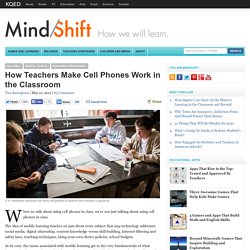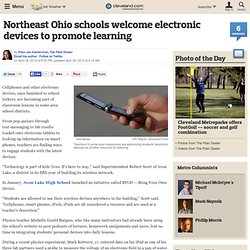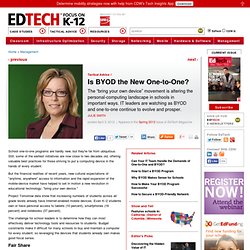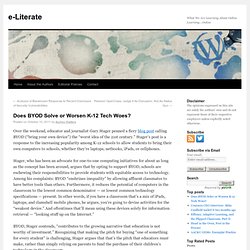

BYOD. EcoMOBILE. - Finally! Research-based proof that students use cell phones for LEARNING. How Teachers Make Cell Phones Work in the Classroom. A.P.

Chemistry students use their cell phones to answer their teacher's question. When we talk about using cell phones in class, we’re not just talking about using cell phones in class. The idea of mobile learning touches on just about every subject that any technology addresses: social media, digital citizenship, content-knowledge versus skill-building, Internet filtering and safety laws, teaching techniques, bring-your-own-device policies, school budgets. At its core, the issues associated with mobile learning get to the very fundamentals of what happens in class everyday. At their best, cell phones and mobile devices seamlessly facilitate what students and teachers already do in thriving, inspiring classrooms. In the most ideal class settings, mobile devices disappear into the background, like markers and whiteboards, pencil and paper – not because they’re not being used, but because they’re simply tools, a means to an end.
In Ramsey Musallam’s A.P. Related. 40 Quick Ways To Use Mobile Phones In Classrooms. Added by Katie Lepi on 2012-10-13 Your students have smartphones. If you’re looking for some simple and straightforward ways to easily integrate these powerful little devices into your classroom, look no further. The following 50 tips are simply that: tips. So use a few and toss the rest. However, be sure to try out at least one or two of them! Use educational apps : One of the simplest strategies for engaging students using smartphones involves taking advantage of the thousands of educational apps as supplements.
This is a cross-post from content partners at online universities. Comments are closed. Bring Your Own Device (BYOD) Resources » TIDEs. BYOD/BYOT is a phrase that refers to Bring Your Own Device. Schools that have embraced the BYOD trend are allowing students to bring their computing devices to school. These devices are used for learning purposes in and outside the classroom. Despite recent publications on schools that have successfully implemented the trend, some school districts and even institutions of higher learning have not adopted BYOD “movement.”
BYOD requires strategic planning on hosting different devices, enforcement of AUP (Acceptable User Policy), and cultivating digital citizenship among many other necessities. 77 (And Growing) BYOT/BYOD Resources for Use in the Classroom (Updated 6/26/12) How This School District Turned its Students' Love of Mobile into Better Learning, Test Scores.
Teenagers.

They may forget your request to mow the lawn, fill up the gas and clean their rooms, but they'll never fail to bring their smartphone or tablet when they go out of the house. Indeed, teens would be the dream demographic for an organizational Bring Your Own Device policy - they use them constantly, they could train your IT staff on the latest devices, etc. - apart from the inconvenient fact that you don't really need an iPhone to man the french fry station at Jack in the Box. But schools, that's a whole different ball of wax. Katy Independent School District in Texas figured out how to leverage BYOD with its students, turning what had once been a classroom disruptor into a learning tool - and better test scores. "People were already trying to hide what they were doing on their smartphone because it was illegal by the school rules.
But I'm jumping ahead of myself. mLearning on the Rise in 2012. Mobile Learning – A Quick Start Guide: Get The Free eBook. Sigml - Main. Shared notebook: BYOD. Northeast Ohio schools welcome electronic devices to promote learning. View full sizeOrlin Wagner, Associated PressTeachers in some area classrooms are welcoming students' electronic devices as another resource for learning.

Cellphones and other electronic devices, once banished to school lockers, are becoming part of classroom lessons in some area school districts. Is BYOD the New One-to-One? School one-to-one programs are hardly new, but they're far from ubiquitous.

Still, some of the earliest initiatives are now close to two decades old, offering valuable best practices for those striving to put a computing device in the hands of every student. But the financial realities of recent years, new cultural expectations of "anytime, anywhere" access to information and the rapid expansion of the mobile-device market have helped to set in motion a new revolution in educational technology: "bring your own device. " Portable Gaming Systems.
Cell Phones in Education. Implementation Strategies. BYOT/BYOD - Dealing with the Fallout (Updated) 7 Myths About BYOD Debunked. BYOD | Viewpoint 7 Myths About BYOD Debunked Lisa Nielsen, the author of "Teaching Generation Text: Using Cell Phones to Enhance Learning" and "The Innovative Educator" blog, believes it is time to shatter a few myths about students bringing their own devices (BYOD) to school.

By Lisa Nielsen11/09/11 More than a decade into the 21st century and we are still keeping learners and teachers prisoners of the analog past by enforcing outdated mandates that ban and block them from using the digital resources of their world. Fortunately, today’s students are standing up, speaking out, and, in many cases, using the technology and websites they do not have access to in school to do so. Myth No. 1: BYOD deepens the digital divide. Myth No. 2: BYOD will result in lessons geared toward the weakest device. - e-Literate. Over the weekend, educator and journalist Gary Stager penned a fiery blog post calling BYOD (“bring your own device”) the “worst idea of the 21st century.”

Stager’s post is a response to the increasing popularity among K-12 schools to allow students to bring their own computers to schools, whether they’re laptops, netbooks, iPads, or cellphones. Stager, who has been an advocate for one-to-one computing initiatives for about as long as the concept has been around, argues that by opting to support BYOD, schools are eschewing their responsibilities to provide students with equitable access to technology. Among his complaints: BYOD “enshrines inequality” by allowing affluent classmates to have better tools than others. Furthermore, it reduces the potential of computers in the classroom to the lowest common denominator — or lowest common technology specifications — present. BYOD, Stager contends, “contributes to the growing narrative that education is not worthy of investment.” BYOD Questions to Consider. The buzz in 1-to-1 right now is about BYOD — Bring Your Own Device — and it’s not a fad and it’s not going away.

There’s a convergence of factors causing it including: Hardware is diverse and at price points that are more affordableSchools are hyper budget consciousThe “cloud” (previously called The Internet, the Web and the Information Superhighway) is ideal for core apps which are free or inexpensive with such as Google (although be sure to use GAFE), and ZohoParents are realizing that a digital device is necessary for learningSchools want to be sure students possess 21st Century skills But BYOD upsets apple carts right and left. But then there are the students. They grow and develop and move to the next grade level and out the door to college and to life. In order for BYOD to work well there must be a strong partnership between administration, Board members, teachers, technology, students, and parents. BYOD in Schools Pros and Cons.